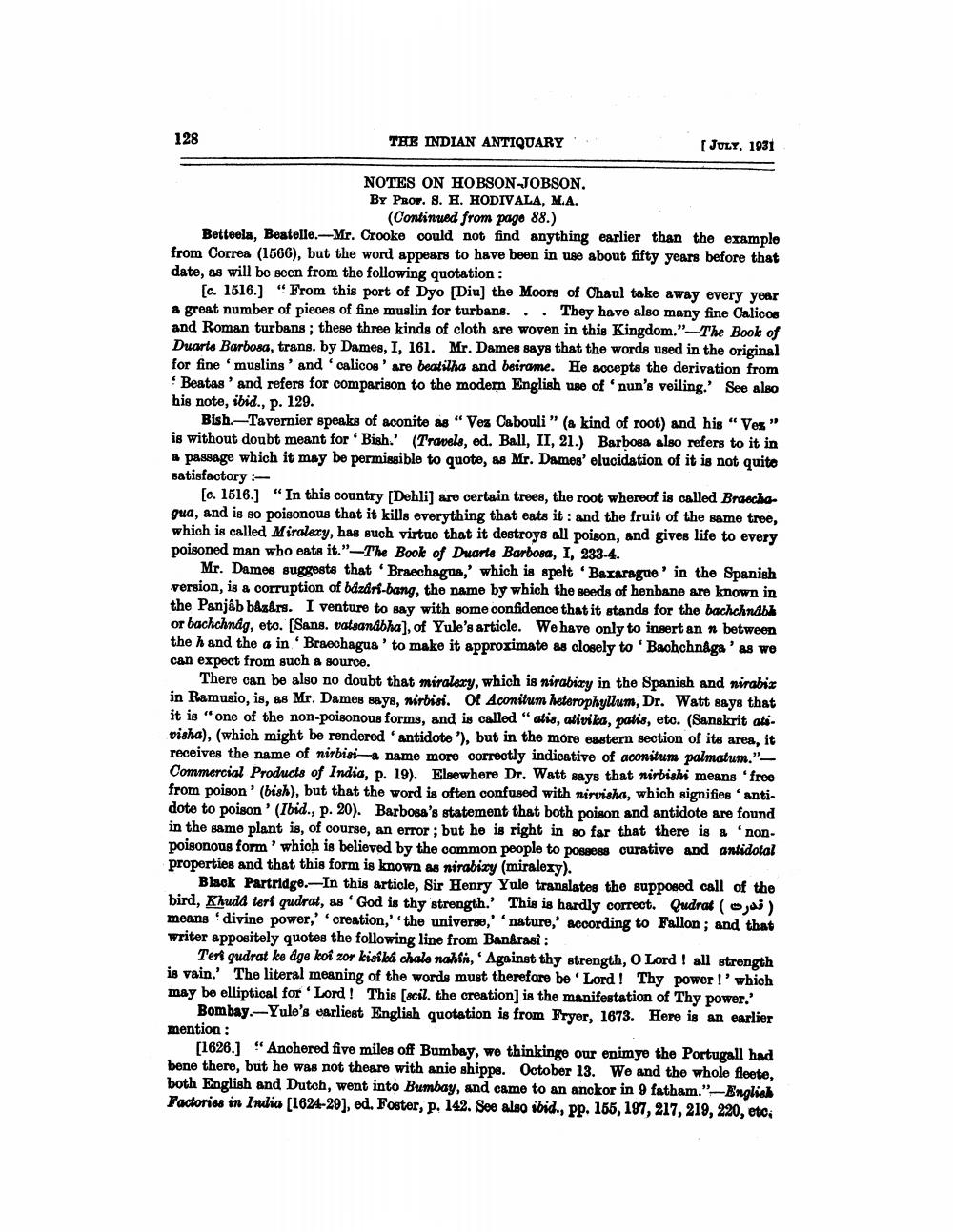________________
128
THE INDIAN ANTIQUARY
[JULY, 1931
NOTES ON HOBSON-JOBSON. BY PROF. 8. H. HODIVALA, M.A.
(Continued from page 88.) Betteela, Beatelle.--Mr. Crooke could not find anything earlier than the example from Correa (1566), but the word appears to have been in use about fifty years before that date, as will be seen from the following quotation:
[c. 1516.) "From this port of Dyo [Diu] the Moors of Chaul take away every year & great number of pieces of fine muslin for turbans... They have also many fine Calicos and Roman turbans; these three kinds of cloth are woven in this Kingdom.”—The Book of Duarts Barbosa, trans. by Dames, I, 161. Mr. Dames says that the words used in the original for fine 'muslins' and 'calicos' are beatilha and beirame. He accepts the derivation from
Beatas' and refers for comparison to the modern English use of 'nun's veiling.' See also his note, ibid., p. 129.
Bish-Tavernier speaks of aconite as "Vez Cabouli” (a kind of root) and his " Ves." is without doubt meant for Bish.' (Travels, ed. Ball, II, 21.) Barbosa also refers to it in a passage which it may be permissible to quote, as Mr. Dames' elucidation of it is not quito satisfactory
[c. 1516.) "In this country [Dehli] are certain trees, the root whereof is called Branchegua, and is so poisonous that it kills everything that eats it : and the fruit of the same tree, which is called Miralexy, has such virtue that it destroys all poison, and gives life to every poisoned man who eats it." -The Book of Drarlo Barbosa, I, 233-4.
Mr. Dames suggests that Braochagua,' which is spelt Bazarague' in the Spanish version, is a corruption of bdzari-bang, the name by which the seeds of henbane are known in the Panjab bazars. I venture to say with some oonfidence that it stands for the bachchndbh or bachchnág, eto. (Sans. vatsanabha), of Yule's article. We have only to insert an n between the h and the a in Braechagua' to make it approximate as closely to Bachchnåga ' as we can expect from such a source.
There can be also no doubt that miralery, which is nirabiry in the Spanish and nirabiz in Ramusio, is, as Mr. Dames Baye, nirbisi. Of Aconitum heterophyllum, Dr. Watt says that it is "one of the non-poisonous forms, and is called "atis, ativika, patis, etc. (Sanskrit atsvisha), (which might be rendered 'antidote '), but in the more eastern section of its area, it receives the name of nirbisi- name more correctly indicative of aconitum palmatum."Commercial Products of India, P. 19). Elsewhere Dr. Watt says that nirbishi means 'free from poison' (bish), but that the word is often confused with nirvisha, which signifies 'antidote to poison (Ibid., p. 20). Barbosa's statement that both poison and antidote are found in the same plant is, of course, an error ; but he is right in so far that there is a nonpoisonous form' which is believed by the common people to possess curative and antidotal properties and that this form is known as nirabizy (miralexy).
Black Partridge. In this article, Sir Henry Yule translates the supposed call of the bird, Khuda teri qudrat, as God is thy strength.' This is hardly correct. Qudrat ( 4) means divine power,' 'creation,' the universe,' 'nature,' according to Fallon; and that writer appositely quotes the following line from Banarasi :
Teri qudrat ko dge kof zor kisild chala nahia, Against thy strength, O Lord ! all strength is vain.' The literal meaning of the words must therefore be 'Lord! Thy power !' which may be elliptical for 'Lord! This scil. the creation) is the manifestation of Thy power.'
Bombay. Yule's earliest English quotation is from Fryer, 1673. Here is an earlier mention:
11628.) "Anohered five miles off Bumbay, we thinkinge our enimye the Portugall had bene there, but he was not theare with anie shipps. October 13. We and the whole floete, both English and Dutch, went into Bumbay, and came to an anckor in 9 fatham."--English Factories in India (1624-29), ed. Foster, p. 142. See also ibid., pp. 165, 197, 217, 219, 220, etc




